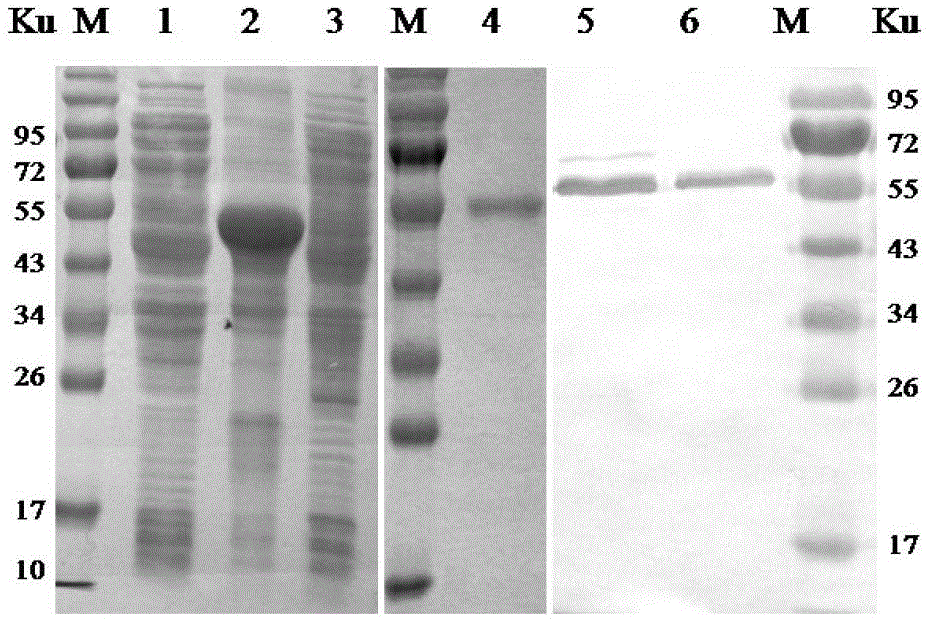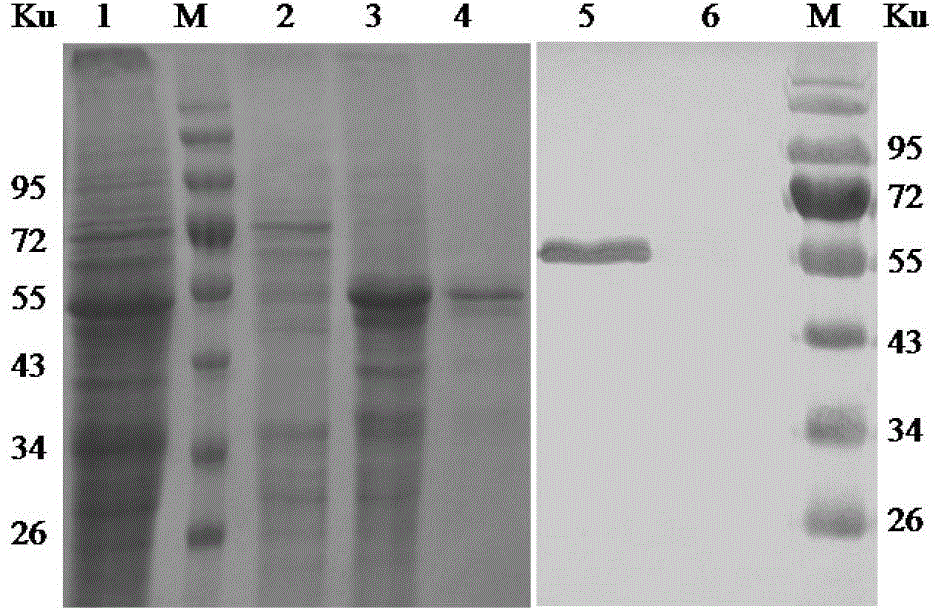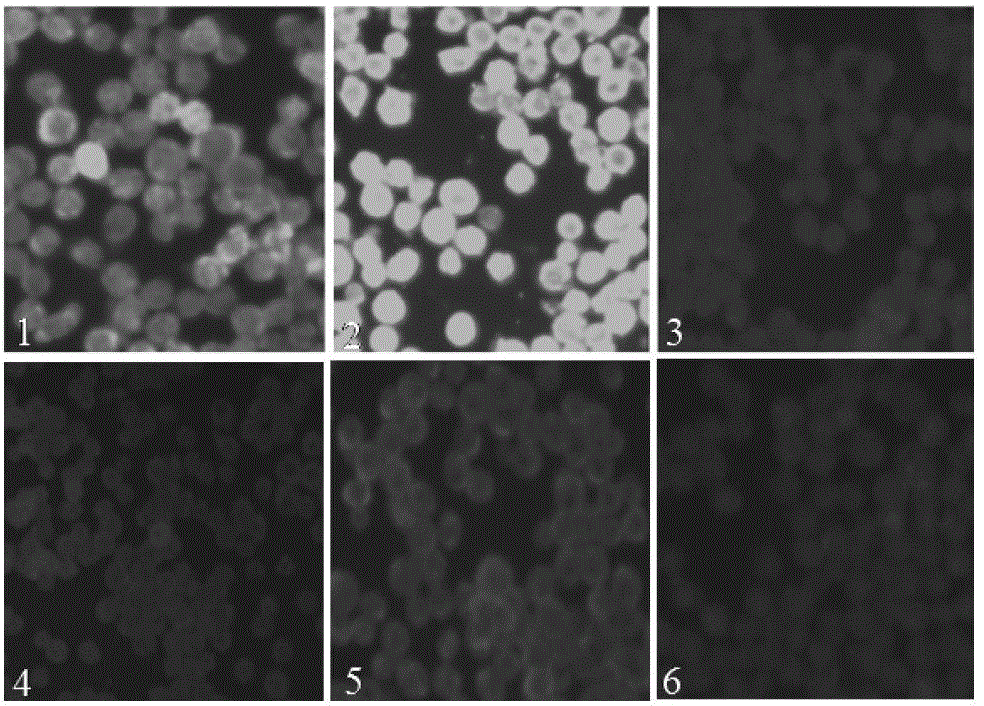Monoclonal antibody (eeev-6e2) against Eastern equine encephalitis virus e2 protein and its recognized B-cell epitope and application
An EEEV-6E2, monoclonal antibody technology, applied in antiviral immunoglobulins, antiviral agents, viral antigen components, etc., can solve the problems of late start of research and poor prognosis of patients
- Summary
- Abstract
- Description
- Claims
- Application Information
AI Technical Summary
Problems solved by technology
Method used
Image
Examples
Embodiment 1
[0031] Prokaryotic and eukaryotic expression and purification of embodiment 1EEEV-E2 protein
[0032] 1. Primer Design
[0033] The prokaryotic expression vector uses pET-30a, and PCR amplification primers are designed according to the known E2 gene sequence of EEEV North American variant strain (GenBank accession number: X63135.1):
[0034] pE-E2-25F:
[0035] 5'-CTggatccGATTTGGACACTCATTTCACCCAGT-3' (BamHI);
[0036] pE-E2-1260-1241R:
[0037] 5'-GCCaagcttTTATGCCCTCGTCGGCTTAATGC-3' (Hind III).
[0038] For eukaryotic expression, the Bac-to-Bac baculovirus expression system was used, and two pairs of PCR amplification primers were designed according to the above sequence:
[0039] pF-E2-25F:
[0040] 5'-CTggatccGGATTTGGACACTCATTTCACCCAGT-3' (BamHI);
[0041] pF-E2-1260-1241R:
[0042] 5'-GCCaagcttTTATGCCCTCGTCGGCTTAATGC-3' (Hind III).
[0043] 2. Construction of prokaryotic expression vector of EEEVE2 protein and prokaryotic expression and purification of EEEVE2 protei...
Embodiment 2
[0062] The preparation of embodiment 2 monoclonal antibody
[0063] 1. Mice Immunization
[0064] The recombinant E2 protein expressed and purified by Bac-to-Bac eukaryotic expression system was used as the immunogen to immunize three 6-week-old female BALB / c mice intraperitoneally, 100 μg / mouse, and immunized three times in total. Mix Freund's complete adjuvant with purified recombinant E2 protein in the first dose; mix Freund's incomplete adjuvant with purified E2 protein in the second and third doses, and mix E2 protein and adjuvant in equal volumes; One week after immunization, blood was collected from the tail vein, and the serum antibody titer was detected by indirect ELISA. Three days before the fusion, the BALB / c mice with higher antibody levels were boosted, and each mouse was directly intraperitoneally injected with 100 μg of purified E2 protein.
[0065] 2. Cell Fusion
[0066] Feeder cells were prepared 1 day before fusion, and BALB / c mouse peritoneal macrophage...
Embodiment 3
[0071] Identification of embodiment 3 monoclonal antibody
[0072] 1. Subclass identification of monoclonal antibodies
[0073] Follow SBA Clonotyping TM System / HRP Antibody Subclass Identification Kit Operating Instructions The monoclonal antibody obtained in Example 1 was used for subclass identification.
[0074] The results show that the heavy chain of the monoclonal antibody EEEV-6E2 of the present invention is IgG 1 , the light chain is a κ chain.
[0075] 2. IFA test (IFA identification of Sf9 cells infected with recombinant baculovirus)
[0076] (1) Use Sf9 insect cell plating (96 cell culture plate), when the cells grow to 80-90% of the bottom area of the plate, inoculate the second-generation recombinant baculovirus BACV-E2 / P2; at the same time, inoculate the wild type under the same conditions Sf9 insect cells with baculovirus (BACV-W) served as a negative control.
[0077] (2) After 48 hours, the cells have obvious lesions, discard the culture medium, add 75...
PUM
 Login to View More
Login to View More Abstract
Description
Claims
Application Information
 Login to View More
Login to View More - R&D
- Intellectual Property
- Life Sciences
- Materials
- Tech Scout
- Unparalleled Data Quality
- Higher Quality Content
- 60% Fewer Hallucinations
Browse by: Latest US Patents, China's latest patents, Technical Efficacy Thesaurus, Application Domain, Technology Topic, Popular Technical Reports.
© 2025 PatSnap. All rights reserved.Legal|Privacy policy|Modern Slavery Act Transparency Statement|Sitemap|About US| Contact US: help@patsnap.com



